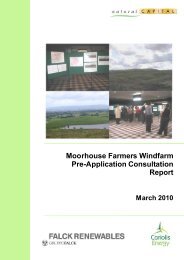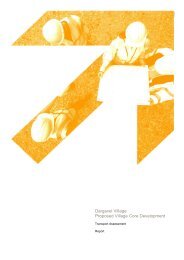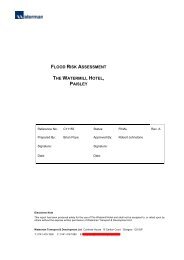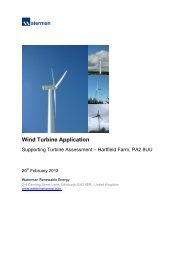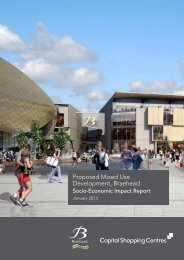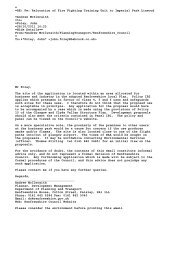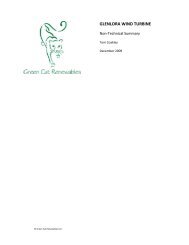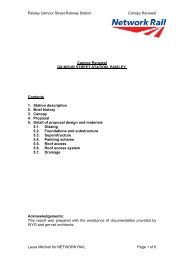Assessment of Planning and Retail Issues - Renfrewshire Council
Assessment of Planning and Retail Issues - Renfrewshire Council
Assessment of Planning and Retail Issues - Renfrewshire Council
You also want an ePaper? Increase the reach of your titles
YUMPU automatically turns print PDFs into web optimized ePapers that Google loves.
PROPOSED EXTENSIONS AT 26 ASSESSMENT OF PLANNING AND RETAIL ISSUES<br />
BRAEHEAD RETAIL PARK MAY 2010<br />
<strong>of</strong> the B&Q reoccupied scenario is £12.5 million, <strong>and</strong> it is this turnover which can<br />
be regarded as potentially being diverted from other retail destinations.<br />
Estimated Trade Diversions Due to Sainsbury Relocation<br />
3.41 We then estimated how the additional £12.5 million trade at Braehead would be<br />
diverted from other shopping destinations, <strong>and</strong> this analysis is set out in Table 20.<br />
For each catchment we estimated how the comparison trade might be<br />
redistributed, having regard to the nature <strong>of</strong> the shopping facilities which would<br />
be likely to be in competition with the improved <strong>of</strong>fer at Braehead, <strong>and</strong> the market<br />
share <strong>and</strong> trade draw patterns revealed in Tables 17 <strong>and</strong> 18.<br />
3.42 We assumed that 70% <strong>of</strong> the new trade at Braehead would be drawn from the<br />
Paisley / Renfrew catchment (Table 20, column 8) - which is considerably higher<br />
than the 52% which Braehead drew from the Paisley catchment when the<br />
household survey was undertaken (Table 10, column 9), reflecting the more<br />
localised catchment <strong>of</strong> the Sainsbury’s element <strong>of</strong> the additional turnover, <strong>and</strong> also<br />
reflecting the prediction in Table 18 that Braehead’s trade draw will tend to<br />
become more localised as the increased competition from other centres takes<br />
effect. We estimated that the remaining trade would be drawn from throughout<br />
the existing Braehead catchment, broadly reflecting the 2003 patterns, except for<br />
the draw from the Pollok area where the trade draw would be lower than in 2003<br />
because <strong>of</strong> the Silverburn effect. Some <strong>of</strong> the trade within the new comparison<br />
floorspace would be diverted from other existing stores within the Braehead<br />
centre, reflecting competition between existing <strong>and</strong> new traders.<br />
3.43 The total effect <strong>of</strong> the estimated trade diversions can be seen in the right-h<strong>and</strong><br />
columns <strong>of</strong> Table 20, where the percentage impacts <strong>and</strong> changes in turnover per<br />
square metre are shown. All the percentage reductions are extremely low (less<br />
than 1%), which is not surprising given that the total trade diversion is only £12.5<br />
million. None <strong>of</strong> these trade diversions would cause any longer-term trading<br />
difficulty in the centres concerned.<br />
3.44 The turnover at Braehead is predicted to increase by 3% as a result <strong>of</strong> the<br />
Sainsbury’s relocation, although still £67 million below the level that it could have<br />
expected to achieve from the main catchment area in 2008 in the absence <strong>of</strong> the<br />
various competing new developments coming on stream. Braehead’s market<br />
share is projected to fall to 6.9% <strong>of</strong> the available spending in its catchment,<br />
compared with its 9% market share in 2003.



